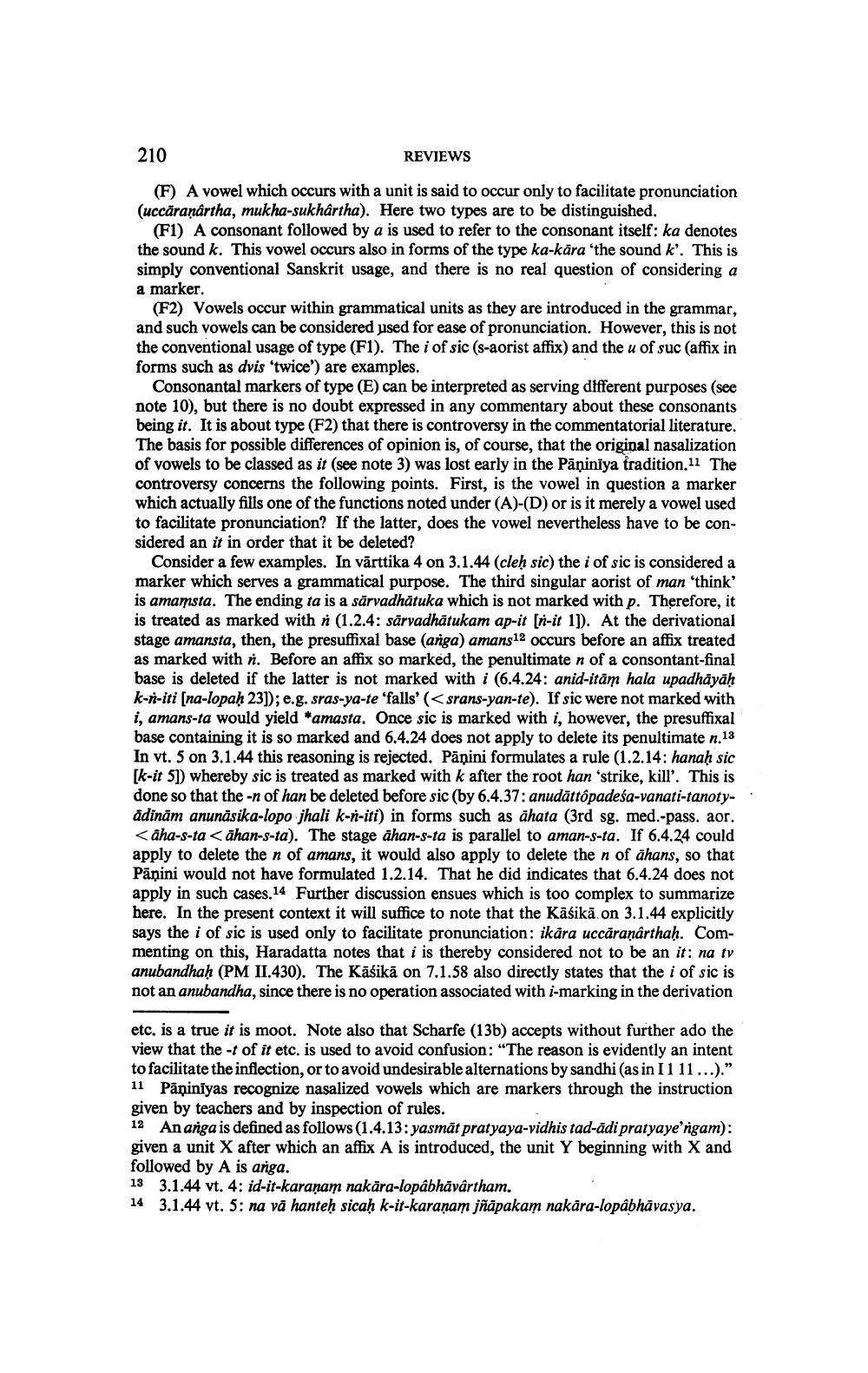Book Title: Reviews Of Different Books Author(s): Publisher: View full book textPage 4
________________ 210 REVIEWS owel which occurs with a unit is said to occur only to facilitate pronunciation (uccaranartha, mukha-sukhartha). Here two types are to be distinguished. (F1) A consonant followed by a is used to refer to the consonant itself: ka denotes the sound k. This vowel occurs also in forms of the type ka-kara "the sound k'. This is simply conventional Sanskrit usage, and there is no real question of considering a a marker. (F2) Vowels occur within grammatical units as they are introduced in the grammar, and such vowels can be considered used for ease of pronunciation. However, this is not the conventional usage of type (F1). The i of sic (s-aorist affix) and the u of suc (affix in forms such as dvis 'twice') are examples. Consonantal markers of type (E) can be interpreted as serving different purposes (see note 10), but there is no doubt expressed in any commentary about these consonants being it. It is about type (F2) that there is controversy in the commentatorial literature. of vowels to be classed as it (see note 3) was lost early in the Paniniya tradition 11 The controversy concerns the following points. First, is the vowel in question a marker which actually fills one of the functions noted under (A)-(D) or is it merely a vowel used to facilitate pronunciation? If the latter, does the vowel nevertheless have to be considered an it in order that it be deleted? Consider a few examples. In varttika 4 on 3.1.44 (cleh sic) the i of sic is considered a marker which serves a grammatical purpose. The third singular aorist of man 'think' is amamsta. The ending ta is a sarvadhatuka which is not marked with p. Therefore, it is treated as marked with (1.2.4: sarvadhatukam ap-it [n-it 1]). At the derivational stage amansta, then, the presuffixal base (anga) amans12 occurs before an affix treated as marked with n. Before an affix so marked, the penultimate n of a consontant-final base is deleted if the latter is not marked with i (6.4.24: anid-itam hala upadhayah k-n-iti (na-lopah 23]); e.g. sras-ya-te 'falls' (< srans-yan-te). If sic were not marked with i, amans-ta would yield *amasta. Once sic is marked with i, however, the presuffixal base containing it is so marked and 6.4.24 does not apply to delete its penultimate n.13 In vt. 5 on 3.1.44 this reasoning is rejected. Panini formulates a rule (1.2.14: hanah sic [k-it 5]) whereby sic is treated as marked with k after the root han 'strike, kill'. This is done so that the-n of han be deleted before sic (by 6.4.37: anudattopadesa-vanati-tanoty-. adinam anunasika-lopo jhali k-n-iti) in forms such as ahata (3rd sg. med.-pass. aor. <aha-s-ta<ahan-s-ta). The stage ahan-s-ta is parallel to aman-s-ta. If 6.4.24 could apply to delete the n of amans, it would also apply to delete the n of ahans, so that Panini would not have formulated 1.2.14. That he did indicates that 6.4.24 does not apply in such cases.14 Further discussion ensues which is too complex to summarize here. In the present context it will suffice to note that the Kasika. on 3.1.44 explicitly says the i of sic is used only to facilitate pronunciation: ikara uccaranarthah. Commenting on this, Haradatta notes that i is thereby considered not to be an it: na ty anubandhah (PM II.430). The Kasika on 7.1.58 also directly states that the i of sic is not an anubandha, since there is no operation associated with i-marking in the derivation etc. is a true it is moot. Note also that Scharfe (13) accepts without further ado the view that the -t of it etc. is used to avoid confusion: "The reason is evidently an intent to facilitate the inflection, or to avoid undesirable alternations by sandhi (as in 11 11 ...)." 11 Paniniyas recognize nasalized vowels which are markers through the instruction given by teachers and by inspection of rules. 12 An anga is defined as follows (1.4.13: yasmat pratyaya-vidhis tad-adi pratyaye'nigam): given a unit X after which an affix A is introduced, the unit Y beginning with X and followed by A is anga. 13 3.1.44 vt. 4: id-it-karanam nakara-lopabhavartham. 14 3.1.44 vt. 5: na va hanteh sicah k-it-karanam jnapakam nakara-lopabhavasya.Page Navigation
1 2 3 4 5 6 7 8 9 10 11 12 13 14 15 16 17 18 19 20 21 22 23 24 25 26 27 28 29 30 31 32 33
